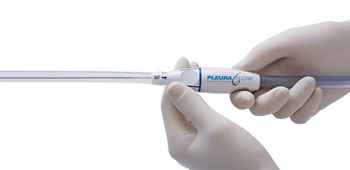Proactive Technology Helps Keep Chest Tubes Clear
By HospiMedica International staff writers
Posted on 23 Aug 2016
A new system proactively clears chest tubes and prevents the retention of blood and fluids in the chest cavity of cardiothoracic surgery patients.Posted on 23 Aug 2016
The PleuraFlow Active Clearance Technology (ACT) system is used to maintain chest tube patency and reduce potential retained blood syndrome (RBS). The system is indicated for use during cardiothoracic surgical procedures and chest trauma. Comprised of a silicone chest tube and a clearance apparatus, the system uses ACT proactively to remove clots formed inside a chest tube to prevent or minimize chest tube occlusion, and to enable evacuation of blood and fluid from the operative site after closure of the surgical wound.

Image: The PleuraFlow system with Active Clearance Technology (ACT) (Photo courtesy of ClearFlow).
The clearance apparatus consists of a guide tube and a polytetrafluoroethylene (PTFE) -coated clearance wire with a loop set on its distal end, bent at a 105-degree angle. The clearance apparatus is advanced into the PleuraFlow Chest tube using a magnetic shuttle. When indicated, the clearance wire and loop is advanced and retracted within the chest tube to proactively prevent or break up and clear any tube obstructions or clogging, keeping the chest tube patent and allowing fluid flow to the drainage canister.
The PleuraFlow Chest Tube is available in four standard sizes. These include a 20 Fr System with four side holes, intended for infant, preadolescent, and adolescent patients undergoing congenital cardiac surgery; a 20 Fr with 6 side holes for a higher flow rate; and 24 Fr and 38 Fr tubes for larger pediatric patients. Each chest tube has a cut length of 48.3 cm, with graduated measurements in centimeters from the distal eyelet, and a barium stripe to facilitate radiographic visualization. The PleuraFlow System is a product of ClearFlow (Anaheim, CA, USA), and has been approved by the U.S. Food and Drug Administration (FDA).
“We commonly hear from pediatric heart surgeons, pediatric intensive care specialists and ICU nurses that they encounter problems with chest tube clogging after heart surgery in children, and sometimes this results in preventable major complications or even fatal consequences,” said Paul Molloy, CEO of ClearFlow. “The older makeshift bedside techniques of stripping or milking conventional chest tubes have been shown ineffective to prevent these problems, and can even be harmful, and thus are banned in many hospitals.”
RBS is a composite of drainage-related complications that are detrimental to outcomes following cardiothoracic surgery and that may require early or late intervention to remediate. These clinical complications have significant economic consequences, including higher costs of care for patients, hospitals, and society at large.
Related Links:
ClearFlow












.jpg)

.jpg)